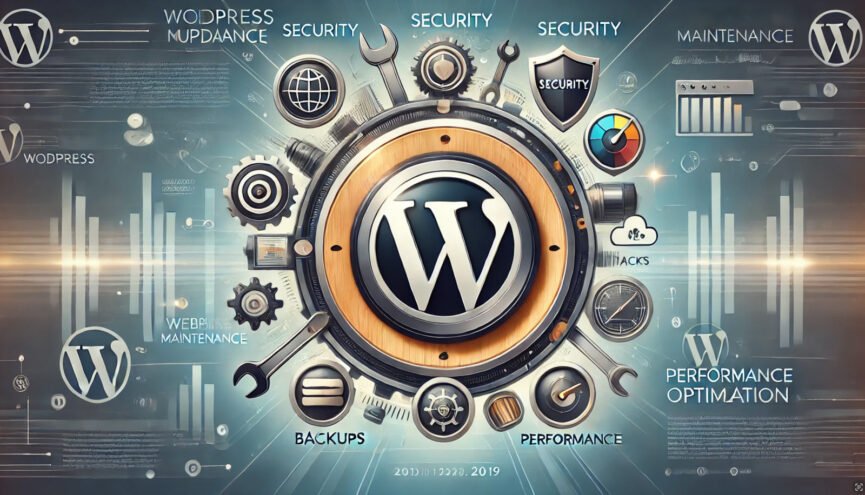A WordPress website isn’t a “set it and forget it” project. Regular maintenance is essential to keep your site secure, fast, and fully functional. Neglecting maintenance can lead to security vulnerabilities, slow performance, broken features, and even downtime, all of which can hurt your business and SEO rankings.
In this guide, we’ll explore why WordPress maintenance is crucial and outline the best practices to keep your website in top shape.
Why is WordPress Maintenance Important?
- Security – WordPress powers over 40% of the web, making it a popular target for hackers. Regular updates and security checks help prevent malware attacks and data breaches.
- Performance Optimization – Slow-loading websites lead to higher bounce rates. Maintenance ensures optimized speed and better user experience.
- SEO Rankings – Google prioritizes fast, well-maintained sites. Broken links, outdated content, and poor site speed can hurt your rankings.
- User Experience – Outdated plugins and themes may cause glitches, broken layouts, and compatibility issues.
- Backup Protection – Regular backups prevent data loss due to server crashes or cyberattacks.
- Legal Compliance – Keeping software updated helps you meet GDPR and other security regulations.
Essential WordPress Maintenance Best Practices
1. Keep WordPress Core, Themes & Plugins Updated
- Updates patch security vulnerabilities and improve performance.
- How to do it:
- Go to Dashboard > Updates to check for updates.
- Enable automatic updates for minor WordPress releases.
- Always test updates on a staging site before applying them to a live site.
2. Perform Regular Backups
- Backups protect against accidental data loss, hacks, or server failures.
- Best backup solutions: UpdraftPlus, VaultPress, or BlogVault.
- How often?
- Daily backups for eCommerce or high-traffic sites.
- Weekly or monthly backups for smaller websites.
3. Optimize Database & Remove Unused Files
- A bloated database slows down your site. Clean up revisions, spam comments, and old plugin data.
- Best tools: WP-Optimize, WP-Sweep.
- Delete unused themes and plugins to improve performance and security.
4. Improve Website Security
- Use firewalls, malware scanners, and login protection.
- Best security plugins: Wordfence, Sucuri, iThemes Security.
- Change the default “admin” username and limit login attempts.
5. Monitor Website Speed & Performance
- Page speed affects SEO and user experience.
- How to check speed: Use Google PageSpeed Insights, GTmetrix, or Pingdom.
- Ways to improve speed:
- Enable caching (WP Rocket, W3 Total Cache).
- Optimize images with Smush or ShortPixel.
- Use a fast hosting provider (SiteGround, Kinsta, WP Engine).
6. Fix Broken Links & Update Outdated Content
- Broken links hurt SEO and create a poor user experience.
- Best tools to find broken links: Broken Link Checker, Ahrefs, Screaming Frog.
- Update outdated blog posts, images, and product descriptions to keep content fresh.
7. Check for Mobile Responsiveness
- Over 60% of traffic comes from mobile devices. Ensure your site is mobile-friendly.
- How to test: Google Mobile-Friendly Test.
- If your site isn’t responsive, update your theme or use responsive design tweaks.
8. Review Website Analytics & Error Logs
- Regularly check Google Analytics for traffic drops, bounce rates, and conversion issues.
- Monitor WordPress error logs for recurring issues and debugging.
- Use Google Search Console to find indexing and mobile usability issues.
9. Enforce Strong User Management & Roles
- Limit admin access to only necessary users.
- Use two-factor authentication (2FA) for admins.
- Remove old user accounts that no longer need access.
10. Schedule a Monthly Maintenance Routine
A maintenance checklist ensures consistency:
- ✅ Check and install WordPress core, theme, and plugin updates.
- ✅ Run a full website backup.
- ✅ Scan for malware and security vulnerabilities.
- ✅ Test website speed and optimize performance.
- ✅ Fix broken links and update content.
- ✅ Review analytics for traffic and performance insights.
- ✅ Remove unused plugins and themes.
Should You DIY or Hire a Maintenance Service?
- DIY Maintenance: Works for small websites, but requires technical knowledge and time commitment.
- Hiring a Professional: Ideal for businesses that want a worry-free solution with expert monitoring.
If you want to focus on your business instead of website maintenance, we offer professional WordPress maintenance services. Contact us today for a custom maintenance plan that keeps your site secure, fast, and optimized.
Final Thoughts
Regular WordPress maintenance is essential for keeping your website secure, optimized, and ranking high in search engines. By following these best practices, you can avoid common issues, improve user experience, and ensure your website’s long-term success.
Need help maintaining your WordPress site? Let us handle it for you! Get in touch today for expert WordPress maintenance services.
Ensure Your WordPress Site Stays Secure & Optimized – Contact Us Now!

